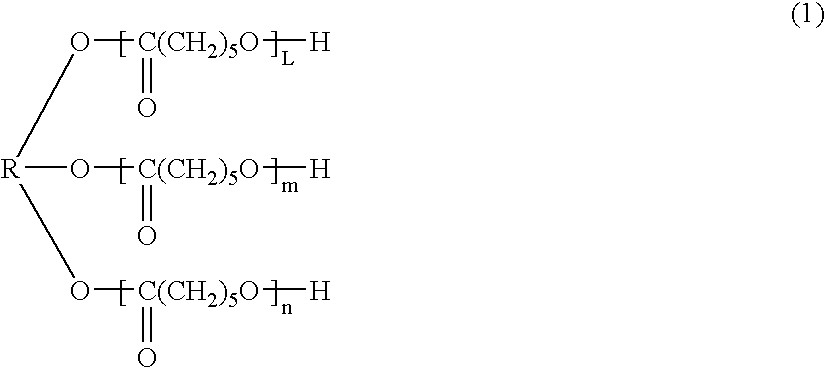Cleaning blade member
a technology of cleaning blades and blades, applied in the field of cleaning blade parts, can solve the problems of cleaning blade wear and unsatisfactory blades, and achieve the effect of excellent wear resistan
- Summary
- Abstract
- Description
- Claims
- Application Information
AI Technical Summary
Benefits of technology
Problems solved by technology
Method used
Image
Examples
example 1
[0031] Polycarbonatediol (100 parts by weight) with a molecular weight of 2,000 using 1,6-hexanediol (1,6HD) as a base diol, 40 parts by weight of MDI, and a 1,3-propanediol / trimethylolethane mixture (80 / 20) as a crosslinking agent in such an amount as to give an α value of 0.95 were mixed. Further, 0.05 part by weight of MP-4 (monobutyl phosphate) of DAIHACHI CHEMICAL INDUSTRY was added as a curing retarder. The mixture was reacted to form a polyurethane, from which a test sample and a cleaning blade were produced. The content of the polycarbonatediol in the polyurethane was about 60% by weight.
example 2
[0032] A test sample and a cleaning blade were produced in the same manner as in Example 1, except that a caprolactone-based triol having a molecular weight of 500 was used instead of the trimethylolethane.
example 3
[0033] A test sample and a cleaning blade were produced in the same manner as in Example 1, except that a caprolactone-based triol having a molecular weight of 800 was used instead of the trimethylolethane.
PUM
| Property | Measurement | Unit |
|---|---|---|
| Temperature | aaaaa | aaaaa |
| Temperature | aaaaa | aaaaa |
| Fraction | aaaaa | aaaaa |
Abstract
Description
Claims
Application Information
 Login to View More
Login to View More - R&D
- Intellectual Property
- Life Sciences
- Materials
- Tech Scout
- Unparalleled Data Quality
- Higher Quality Content
- 60% Fewer Hallucinations
Browse by: Latest US Patents, China's latest patents, Technical Efficacy Thesaurus, Application Domain, Technology Topic, Popular Technical Reports.
© 2025 PatSnap. All rights reserved.Legal|Privacy policy|Modern Slavery Act Transparency Statement|Sitemap|About US| Contact US: help@patsnap.com

